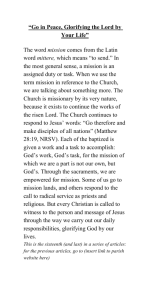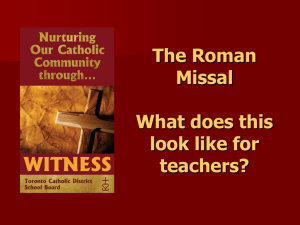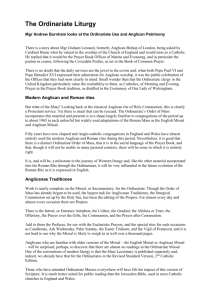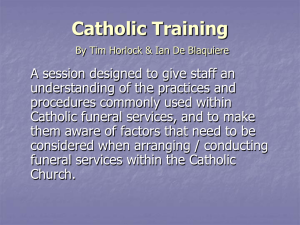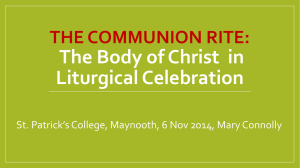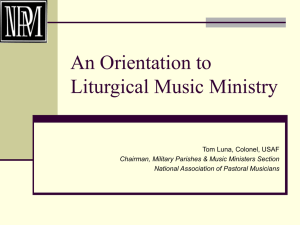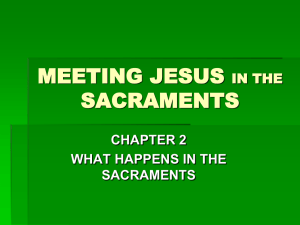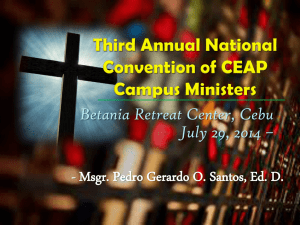Presentation 21 June 2011
advertisement
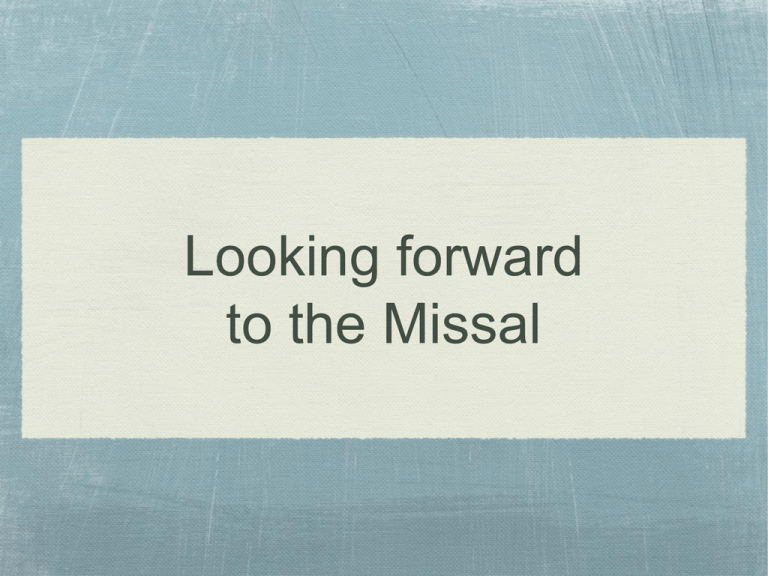
Looking forward to the Missal Starter Questions Looking at the text Preparing for, and reflecting on Liturgy Resources Strategy Reflect One good thing about the celebration of Mass in your school or college One thing you would like to improve Starter Questions What are we talking about? Missal — book containing prayers used by priest & people at the celebration of Mass Lectionary — book containing scripture readings used at Mass [People’s Missals — selected texts from Missal & Lectionary] Core book of Roman Liturgy With Calendar foundation & start of liturgical renewal Used at every Mass Expectation from 1st English translation 2001 Liturgiam Authenticam Vatican Guidelines on translation 2002 New edition (3rd) of Latin Roman Missal Revised General Instruction of Roman Missal (2005) Calendar Optional memorials Vigils for Epiphany, Ascension and Pentecost Prayers over the People for each day of Lent Apostles’ Creed especially during Lent and Easter Some additional orations and prefaces Inclusion / exclusion of Eucharistic Prayers Interpolations in Eucharistic Prayers Liturgiam Authenticam New principles of translation formal over dynamic equivalence weight placed on words over sentences May these, and all who sleep in Christ, find in your presence light, happiness, and peace. Ipsis, Domine, et omnibus in Christo quiescentibus, locum refrigerii, lucis et pacis, ut indulgeas, deprecamur. Grant them, O Lord, we pray, and all who sleep in Christ, a place of refreshment, light and peace. Concerns over-simplification - how do you translate liturgical prayer for proclamation? loss of meaning and nuance the position of English lex orandi ~ lex credendi • Qui hominem pietatis tuae dono creatum ad tantam voluisti dignitatem extolli, ut in viri mulierisque consortio veram relinqueres tui amoris imaginem quem enim ex caritate creasti eum ad caritatis legem vocare non desinis ut aeternae tuae caritatis participem esse concedas. Cuius connubii sancti mysterium dum tuae dilectionis signum exsistit, amorem sacrat humanum: • You created man in love to share your divine life. We see his high destiny in the love of husband and wife, which bears the imprint of your own divine love. Love is man’s origin, love is his constant calling, love is his fulfillment in heaven. The love of man and woman is made holy in the sacrament of marriage, and becomes the mirror of your everlasting love. • Qui hominem pietatis tuae dono creatum ad tantam voluisti dignitatem extolli, ut in viri mulierisque consortio veram relinqueres tui amoris imaginem quem enim ex caritate creasti eum ad caritatis legem vocare non desinis ut aeternae tuae caritatis participem esse concedas. Cuius connubii sancti mysterium dum tuae dilectionis signum exsistit, amorem sacrat humanum: For you willed that the human race, created by the gift of your goodness, should be raised to such high dignity that in the union of husband and wife you might bestow a true image of your love. For those you created out of charity you call to the law of charity without ceasing and grant them a share in your eternal charity. And so, the Sacrament of holy Matrimony, as the abiding sign of your own love, consecrates the love of man and woman, Completely new translation Nearly all common responses have changed Richer & more faithful Style is more complex Scriptural allusions Requires preparation A chance to discover new riches in the text A chance to reflect and deepen liturgical practice New edition in preparation. Not imminent Text drawn from NRSV & Grail Psalms revised in the light of Liturgiam Authetnticam Where are we now? & how did we get here? & what happens next? April 2010 — Holy See announces recognitio of Missal August 2010 — England & Wales receive text Autumn 2010 — resolution of discrepancies December 2010 — final text of complete Missal February 2011 — England & Wales receives particular texts March 2011 — finalising Altar edition & sent to printers June 2011 — Order of Mass for September published November 2011 — full Altar Missal published September 2011 Order of Mass introduced Catechesis on Eucharist Translation Advent 2011 Full Altar Missal published Use of full text Those texts which are the same at every Mass: Greetings Or not these: Entrance & Communion Antiphons Opening Prayer Dialogues Prayer over Gifts Holy, Holy Prayer after Communion etc also Eucharistic Prayers Questions, comments so far… Looking at the Text Process look at text for ourselves consider implications for school liturgy Their purpose is to ensure that the faithful, who come together as one, establish communion and dispose themselves properly to listen to the Word of God and to celebrate the Eucharist worthily. [girm 46] Entrance Sign of the Cross Greeting Penitential Act Gloria Collect In groups look through the texts What strikes you? What do you like? What challenges you? Entrance Sign of the Cross Greeting Penitential Act Gloria Collect Noticing what has always been there Old & New The different languages of liturgy Key changes Key points for catechesis Introductory Rites & Directory for Masses with Children Introducing changes Good practice Reflection What are the implications for my School? Liturgy of the Word Sanctus Gospel Dialogue Memorial Acclamations Nicene/Apostles’ Creed Invitation to Communion Liturgy of the Eucharist Prayer over the Offerings Preface Dialogue Concluding Rite Dismissals Reflecting on the Liturgy How were you feeling when you came in? What were your thoughts? What stays with you? Your overall impression? What phrases or words do you recall? What did you hear? How did you respond? What insights has this experience given you about the new translation? And for when you will introduce it? Resources Missals Participation Aids Music Formation published by Catholic Truth Society 3 sizes Altar edition Chapel edition Study edition Redemptorist Catholic Truth Society Mass Card Wallet Card Order of Mass booklet Order of Mass in Latin & English McCrimmons Mass Card Mass Card Mass booklet Children’s versions John Neale Mass Card & Mass booklet Catholic Printing - Farnworth Mass Card & booklet Liturgy Office website Model leaflets Model PowerPoints Missal Chants Rewritten settings settings Mass of Creation Storrington Celtic Liturgy Belmont Gathering MacMillan Farrell etc. What would be a set of basic ingredients? 3 Gospel Acclamations 1 loud, 1 soft, 1 Lenten 1 set of Eucharistic Acclamations (Holy, Memorial Acclamations, Amen) What would be a set of basic ingredients? 4 psalm (responses) - can be used in a variety of ways Psalm of blessing (Ps 33 — Taste and See) Psalm of praise () Psalm of hope (Ps 26 — The Lord is my light) Psalm of sorrow/petition (Ps 90 - Be with me, Lord) And then… Gloria Kyrie/Intercession response 2 stages Preparatory — from May Introduction — from September Understanding the revised Mass texts Paul Turner McCrimmons/LTP Become One Body One Spirit in Christ interactive DVD Bishops’ Conference Welcome to the Mass Pauline Books & Media Preparation Introduction Deanery Sessions Liturgy Notes Diocesan/Parish presentations Catechesis Notes Homily Notes In Spirit & in Truth small groups Handouts: general & family Liturgical Ministers Going deeper into the text Bulletin Inserts All will be available from Liturgy Office website: www.liturgyoffice.org.uk/Missal or www.Missal.org.ukparticular material for schools www.liturgyoffice.org.uk/Missal/Resources/Schools/ Martin.Foster@cbcew.org.uk Questions In Groups Before the first time Mass is celebrated in school in September what needs to be in place? What resources are needed? Who needs to be informed? What other questions need to be considered? Feedback The final word. Entrance Sign of the Cross Greeting Penitential Act Gloria Collect Formation who is affected? what level of formation do they need? Questions Looking ahead The Priest then takes the paten or ciborium and approaches the communicants, who usually come up in procession It is not permitted for the faithful to take the consecrated Bread or the sacred chalice by themselves and, still less, to hand them on from one to another among themselves. In the Dioceses of England and Wales Holy Communion is to be received standing, though individual members of the faithful may choose to receive Communion while kneeling. However, when they communicate standing, it is recommended that the faithful bow in reverence before receiving the Sacrament What is good about your current practice? What would you like to improve? The sign of reverence — who is affected? Which ministers will be key in its implementation? What formation will be necessary?
